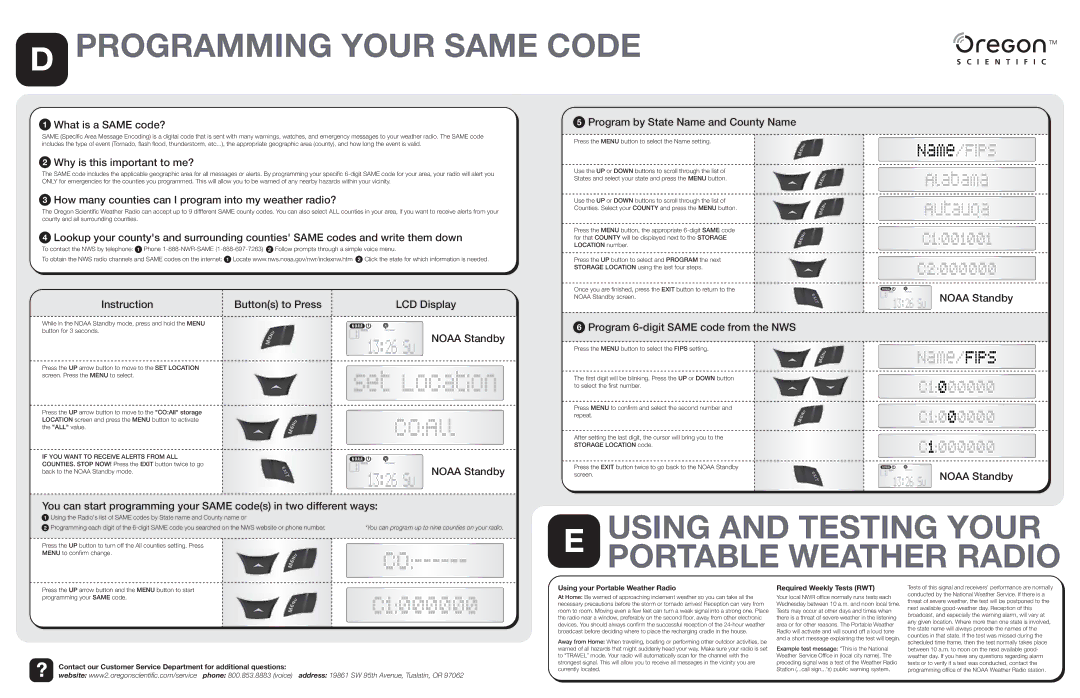
DPROGRAMMING YOUR SAME CODE
1What is a SAME code?
SAME (Specific Area Message Encoding) is a digital code that is sent with many warnings, watches, and emergency messages to your weather radio. The SAME code includes the type of event (Tornado, flash flood, thunderstorm, etc...), the appropriate geographic area (county), and how long the event is valid.
2Why is this important to me?
The SAME code includes the applicable geographic area for all messages or alerts. By programming your specific
3How many counties can I program into my weather radio?
The Oregon Scientific Weather Radio can accept up to 9 diffferent SAME county codes. You can also select ALL counties in your area, if you want to receive alerts from your county and all surrounding counties.
4Lookup your county's and surrounding counties' SAME codes and write them down
To contact the NWS by telephone: 1 Phone
To obtain the NWS radio channels and SAME codes on the internet: 1 Locate www.nws.noaa.gov/nwr/indexnw.htm 2 Click the state for which information is needed.
Instruction | Button(s) to Press | LCD Display |
5Program by State Name and County Name
Press the MENU button to select the Name setting.
Use the UP or DOWN buttons to scroll through the list of
States and select your state and press the MENU button.
Use the UP or DOWN buttons to scroll through the list of
Counties. Select your COUNTY and press the MENU button.
Press the MENU button, the appropriate
Press the UP button to select and PROGRAM the next
STORAGE LOCATION using the last four steps.
Once you are finished, press the EXIT button to return to the
NOAA Standby screen.
Name/FIPS
Alabama
Autauga
C1:001001
C2:000000
NOAA Standby
While in the NOAA Standby mode, press and hold the MENU button for 3 seconds.
Press the UP arrow button to move to the SET LOCATION screen. Press the MENU to select.
Press the UP arrow button to move to the "CO:All" storage LOCATION screen and press the MENU button to activate the "ALL" value.
IF YOU WANT TO RECEIVE ALERTS FROM ALL COUNTIES. STOP NOW! Press the EXIT button twice to go back to the NOAA Standby mode.
NOAA Standby
Set Location
Co:All
NOAA Standby
6Program 6-digit SAME code from the NWS
Press the MENU button to select the FIPS setting.
The first digit will be blinking. Press the UP or DOWN button to select the first number.
Press MENU to confirm and select the second number and repeat.
After setting the last digit, the cursor will bring you to the
STORAGE LOCATION code.
Press the EXIT button twice to go back to the NOAA Standby screen.
Name/FIPS
C1:000000
C1:000000
C1:000000
NOAA Standby
You can start programming your SAME code(s) in two different ways:
1 | Using the Radio's list of SAME codes by State name and County name or |
|
2 | Programming each digit of the | *You can program up to nine counties on your radio. |
Press the UP button to turn off the All counties setting. Press
MENU to confirm change. | Co: |
|
EUSING AND TESTING YOUR PORTABLE WEATHER RADIO
Press the UP arrow button and the MENU button to start | C1:000000 |
programming your SAME code. | |
|
Contact our Customer Service Department for additional questions:
website: www2.oregonscientific.com/service phone: 800.853.8883 (voice) address: 19861 SW 95th Avenue, Tualatin, OR 97062
Using your Portable Weather Radio
At Home: Be warned of approaching inclement weather so you can take all the necessary precautions before the storm or tornado arrives! Reception can vary from room to room. Moving even a few feet can turn a weak signal into a strong one. Place the radio near a window, preferably on the second floor, away from other electronic devices. You should always confirm the successful reception of the
Away from Home: When traveling, boating or performing other outdoor activities, be warned of all hazards that might suddenly head your way. Make sure your radio is set to “TRAVEL” mode. Your radio will automatically scan for the channel with the strongest signal. This will allow you to receive all messages in the vicinity you are currently located.
Required Weekly Tests (RWT)
Your local NWR office normally runs tests each Wednesday between 10 a.m. and noon local time. Tests may occur at other days and times when there is a threat of severe weather in the listening area or for other reasons. The Portable Weather Radio will activate and will sound off a loud tone and a short message explaining the test will begin.
Example test message: "This is the National Weather Service Office in (local city name). The preceding signal was a test of the Weather Radio Station (...call sign...'s) public warning system.
Tests of this signal and receivers' performance are normally conducted by the National Weather Service. If there is a threat of severe weather, the test will be postponed to the next available
